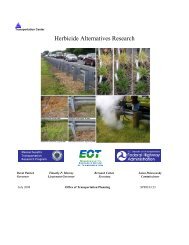Final Environmental Impact Report - Whittier Bridge/I-95 ...
Final Environmental Impact Report - Whittier Bridge/I-95 ...
Final Environmental Impact Report - Whittier Bridge/I-95 ...
- No tags were found...
Create successful ePaper yourself
Turn your PDF publications into a flip-book with our unique Google optimized e-Paper software.
<strong>Whittier</strong> <strong>Bridge</strong>/I-<strong>95</strong> Improvement Project FEIR<br />
Chapter 2.0: Response to Comments on the <strong>Environmental</strong> Assessment/Draft <strong>Environmental</strong> <strong>Impact</strong> <strong>Report</strong><br />
design, with spans twice the length of the <strong>Whittier</strong> and trusses proportionally larger, seventeen years older, subject to<br />
the same, if not worse weather conditions, is still functioning smoothly and is well-maintained, while the <strong>Whittier</strong> is<br />
undoubtedly in need of a major overhaul or , replacement. WHY IS IT THAT THE SAGAMORE WAS<br />
REHABILITATED IN THE 1980'S, INCLUDING DECK AND CABLE REPLACEMENT, FOR $20 MILLION, CLOSING<br />
ONE LANE AT A TIME, WHILE THE DOT CLAIMS THIS IS IMPOSSIBLE FOR THE WHITTIER<br />
Response: Although similar, the environmental winter conditions are very different for the <strong>Whittier</strong><br />
<strong>Bridge</strong> and the Sagamore <strong>Bridge</strong> over the Cape Cod Canal. The weather on Cape Cod is relatively<br />
more temperate then the Merrimack Valley, and this requires less deicing salts which are<br />
problematic for the lattice built-up truss members. During the winter months the <strong>Whittier</strong> <strong>Bridge</strong><br />
experiences almost daily freeze and thaw cycles, while the Sagamore <strong>Bridge</strong> experiences far fewer<br />
freeze and thaw cycles. In addition, I-<strong>95</strong> has a higher operating speed and a higher volume of truck<br />
traffic than US Route 6 over the Sagamore <strong>Bridge</strong>. All of these issues contribute to the deterioration<br />
of the structure resulting in the structural obsolescence of the <strong>Whittier</strong> <strong>Bridge</strong>. The <strong>Whittier</strong> <strong>Bridge</strong><br />
underwent a complete deck replacement in the 1970s when traffic volumes were much lower and a<br />
lane could be taken out of service to perform this work. Hanger modifications were made in the late<br />
1990s to further extend the life of the structure. The structural problems with the <strong>Whittier</strong> <strong>Bridge</strong> go<br />
beyond the need for deck replacement and include deterioration to the arches with widespread pack<br />
rust occurring at the riveted connections which increases the long-term structural risk to the<br />
structure. Structurally non-redundant bridges like the <strong>Whittier</strong> <strong>Bridge</strong> require a more conservative<br />
engineering approach since the tragedy of the I-35W bridge collapse in Minneapolis in 2007.<br />
JH-6: Secondly, the Sagamore comparison begs the obvious question which the DOT should also address: How is it<br />
that between the yearly inspection process and the Department's budget and maintenance procedures the <strong>Whittier</strong><br />
ended up in the decrepit condition it is in today The DOT's own inspection reports claim they have no idea when the<br />
bridge was last painted. Is this really possible (Neighbors don't recall it being painted since the early 1970's.)<br />
Shouldn't the DOT be looking for 'lessons learned' here so we don't end up in the same situation down the road with<br />
a new bridge Obviously, if the bridge had been properly maintained all these years, this discussion wouldn't even be<br />
taking place.<br />
Response: MassDOT‘s bridge and structural engineers for the project have determined that the<br />
<strong>Whittier</strong> <strong>Bridge</strong> cannot be safely rehabilitated.<br />
The <strong>Whittier</strong> <strong>Bridge</strong> is a steel-riveted built-up truss bridge built in 1<strong>95</strong>1. Truss bridges comprise<br />
multiple non-redundant members. A failure of one member, in either tension or compression, could<br />
cause the bridge to collapse. The bridge was originally designed to carry only two lanes of traffic in<br />
each direction with full breakdown lanes. In the 1960s, it was reconfigured to three lanes without<br />
shoulders in each direction, and traffic volumes have increased the fatigue loading by 50 percent.<br />
Significant corrosion has also occurred to structural elements of the bridge, including truss floor<br />
beams and stringers, bracing, wind chords, and gusset plates, with the most severe deterioration<br />
occurring to members exposed to deicing salts at the edges of the bridge and in the open medians<br />
between the northbound and southbound roadways. Substantial recent repairs have been completed<br />
to maintain the bridge in a safe condition for existing traffic and to ensure public safety. However,<br />
these repairs are temporary and address only the immediate load-carrying needs of the bridge; they<br />
neither provide permanent repairs nor do they address long-term fatigue-life considerations.<br />
Because of the extensive deterioration of the existing structure, the temporary nature of the near-<br />
2-60
















